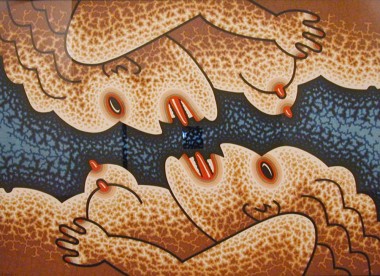Gordy never made the national spotlight, but his early works rank among the best
by Doug MacCash
The Times-Picayune: Lagniappe, August 4, 2000

Gordy's jigsaw puzzle-like early paintings required meticulous planning. This 3 x 4 foot felt-tip marker drawing, 'Two Faced,' was a preliminary sketch for a later, large acrylic-on-canvas painting. His paintings were labor-intensive, to say the least.
By the time Robert Gordy died in 1986 at age 52, he had already created two of the most original and influential styles ever to emerge from New Orleans.
During his later, briefer (five year) stylistic period, he produced a long series of psychologically intense, Expressionistic portraits that represented the AIDS epidemic. He created those riveting, distorted faces of men with a then-unusual printing technique known as monotype. Monotypes are one-of-a-kind renderings produced by swiftly painting designs directly onto a Formica printing plate, then placing paper over the plate and rolling it through a printing press as if it were an etching. Gordy pioneered the now-popular method locally.
Those quickly made, emotionally charged monotypes were preceded by an earlier, more meticulous and laborious style of painting. The “Robert Gordy: Early Works” exhibit at Arthur Roger Gallery, which includes acrylic on canvas paintings and felt-tip marker drawings from 1964-82, documents this earlier style.
It may be easiest to describe Gordy’s first body of work by talking about what it was not. Look at his 1977 masterpiece “Two Faced,” for instance. It’s obvious from the duplicate female forms that Gordy was fascinated by the simplified, schematic human shapes in the so-called primitive art from Easter Islands to the Aleutians to ancient Egypt. But Gordy didn’t produce faux-primitive art; he simply incorporated the powerful ethnographic designs into his own work. It’s also clear that Gordy was no stranger to the comic strip art that influenced so many artists of this generation. The bulbous, clumsy women in “Two Faced” are distant cousins of Popeye, Nancy and The Checkered Demon, but Gordy never made purely Pop art. His work was far too warm and personal for Pop.
Gordy obviously understood the unbroken contour lines that Matisse used to flatten forms, but he was no Fauve. He never imitated the breezy spirit or fiery colors of Matisse (in fact, Gordy was a master of quietly modulated tones). He was obviously intrigued by the decorative pattern-making of his contemporaries such as Miriam Schapiro and Joyce Kozloff, but he never produced the quilts, printed fabric or other Folk Art forms of the Pattern Art movement. He even seems to have admired the rigidity and formulaic quality of Minimalist painting, which was a hot national style at the start of his career (his jigsaw designs were almost as stiff and repetitive as Agnes Martin’s grids or Frank Stella’s spiraling squares), but Gordy as too much of a visual storyteller to be satisfied by pure abstraction.
Because there were so many things that Gordy’s style was not, we’re left with one conclusion: It was truly original. When art historians try to place Gordy in a general movement in art, they choose the Chicago Imagist school of the 1970s and 80s. Though Gordy’s studio was roughly 1,000 miles south of the Windy City, they’re right. His early work fits well with the painstaking, cartoon-influenced and very idiosyncratic painting of Roger Brown, Jim Nutt, Ed Paschke and others who collectively rebelled against the cold, conceptual art that dominated the national scene. Gordy and the others were some of the best artists of their time, though they are rarely included in textbooks that survey American art. Why?
That’s the question posed by the “Robert Gordy: Early Work” exhibit, which demonstrates anew the uncompromising, seemingly world-class quality of his work. Stand in front of almost any major piece in the show “Les Lutteurs #2,” “In the Garden,” “Summer #4” or any other. Now recall the stick-figure paintings of New York art star Keith Haring, who became a marketplace and museum phenomenon in the decade after Gordy painted most of these canvases. The two artists’ aesthetics were quite similar: Neo-primitive, cartoon-influenced art made up of interlocking patterns, which depicted human foibles in simple allegorical terms. Now ask yourself, how on earth did Haring (here you can substitute Mark Kostabi, Kenny Scharf or a dozen other 80s stars) become an internationally celebrated artist, whose work appears in every art-historical text of the period, while Gordy (substitute any of the Chicago Imagists) remained only a small-town hero becoming more obscure with each passing day? Your eyes will tell you that Gordy’s work was similar to Haring’s, but technically more sophisticated in dozens of ways – and he was doing it more than a decade earlier.
Is it because Haring had a sexy gimmick – drawing in chalk on the subway signs in New York as if he were a homeless street artist – which caught the imagination of the critics? Is it because Gordy was simply unknown to the national art press that establishes art movements (actually Gordy’s work appeared in the 1973 Whitney Museum of American Art biennial exhibition, years before Haring’s work)? Is it because Haring, who died of AIDS, became a heroic symbol for the disease’s decimation of the art community (Gordy also died of AIDS)? Or is it because the quality and originality of an artist’s work isn’t the deciding factor in national art stardom? Is it possible that an artist’s art-historical importance is based more on popular success in the New York art scene than in any objective measure of talent or dedication. And if that’s true, is it possible that some of the regional artists you discover as you stroll Julia and Magazine streets are every bit as good as the ones you read about in Art in America? Take a long look at Gordy’s splendid “Desert Nights #4,” the most sublime piece in the show, and you tell me.
